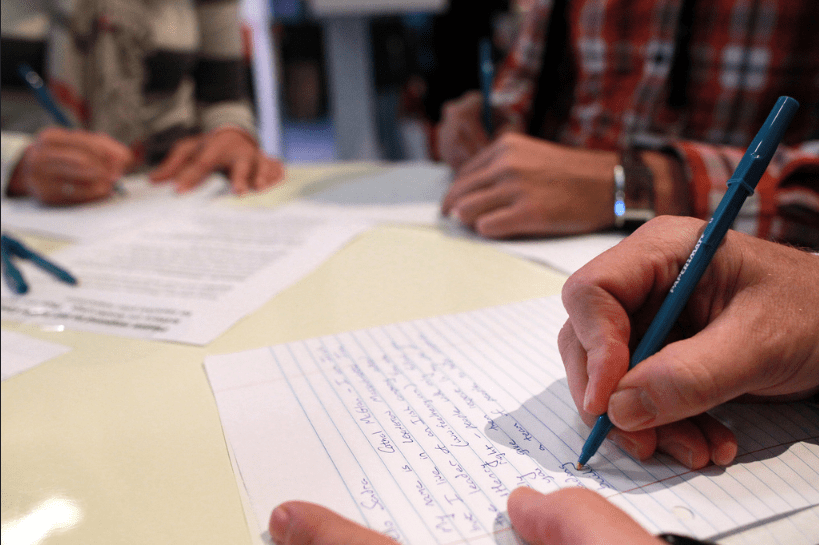Quick Look
Grade Level: 5 (4-6)
Time Required: 1 hours 45 minutes
(two 50-minute sessions)
Expendable Cost/Group: US $0.00
Group Size: 1
Activity Dependency: None
NGSS Performance Expectations:

| 5-ESS3-1 |

Summary
Communicating how engineers can solve problems plays an important role in helping people understand their contributions to our planet. Take air pollution as an example. In this activity, students write letters as part of an environmental action campaign They become more aware of how air pollution is a global environmental problems and play a part in its solution. They incorporate source materials into their speaking and writing, learn to write and speak in the content areas using the technical vocabulary of the subject accurately, and read, respond to and discuss literature that represents diverse points of view.Engineering Connection
Because environmental engineers are so knowledgeable about air pollution problems, they contribute in many ways towards solutions to this global health issue. Some engineers study the origins and impact of air pollution, and design technologies to prevent it or clean it up. Other engineers educate and advise the public and government about the impact on human health and the environment, using their expertise to deliver a strong message so that action is taken to require the reduction of pollution.
Learning Objectives
After this activity, students should be able to:
- write letters as part of an environmental action campaign.
- incorporate source materials into their speaking and writing (for example, interviews, news articles, encyclopedia information).
- write and speak in the content areas using the technical vocabulary of the subject accurately.
- read, respond to and discuss literature that represents points-of-view from places, people, and events that are familiar and unfamiliar.
Educational Standards
Each TeachEngineering lesson or activity is correlated to one or more K-12 science,
technology, engineering or math (STEM) educational standards.
All 100,000+ K-12 STEM standards covered in TeachEngineering are collected, maintained and packaged by the Achievement Standards Network (ASN),
a project of D2L (www.achievementstandards.org).
In the ASN, standards are hierarchically structured: first by source; e.g., by state; within source by type; e.g., science or mathematics;
within type by subtype, then by grade, etc.
Each TeachEngineering lesson or activity is correlated to one or more K-12 science, technology, engineering or math (STEM) educational standards.
All 100,000+ K-12 STEM standards covered in TeachEngineering are collected, maintained and packaged by the Achievement Standards Network (ASN), a project of D2L (www.achievementstandards.org).
In the ASN, standards are hierarchically structured: first by source; e.g., by state; within source by type; e.g., science or mathematics; within type by subtype, then by grade, etc.
NGSS: Next Generation Science Standards - Science
| NGSS Performance Expectation | ||
|---|---|---|
|
5-ESS3-1. Obtain and combine information about ways individual communities use science ideas to protect the Earth's resources and environment. (Grade 5) Do you agree with this alignment? |
||
| Click to view other curriculum aligned to this Performance Expectation | ||
| This activity focuses on the following Three Dimensional Learning aspects of NGSS: | ||
| Science & Engineering Practices | Disciplinary Core Ideas | Crosscutting Concepts |
| Obtain and combine information from books and/or other reliable media to explain phenomena or solutions to a design problem. Alignment agreement: | Human activities in agriculture, industry, and everyday life have had major effects on the land, vegetation, streams, ocean, air, and even outer space. But individuals and communities are doing things to help protect Earth's resources and environments. Alignment agreement: | A system can be described in terms of its components and their interactions. Alignment agreement: Science findings are limited to questions that can be answered with empirical evidence.Alignment agreement: |
International Technology and Engineering Educators Association - Technology
-
Explain how various relationships can exist between technology and engineering and other content areas.
(Grades
3 -
5)
More Details
Do you agree with this alignment?
State Standards
Colorado - Science
-
Examine, evaluate, question, and ethically use information from a variety of sources and media to investigate how environmental conditions affect the survival of individual organisms
(Grade
6)
More Details
Do you agree with this alignment?
Materials List
- Paper and pencils
- Access to the internet
Pre-Req Knowledge
A general familiarity with the issues and problems of air pollution.
Introduction/Motivation
Never underestimate the "power of one," especially when that "one" is part of "many." Today we are going to take part in a letter-writing campaign. We will be writing letters to our elected officials about a common concern: air pollution. Why letters? Letter-writing campaigns can help citizens reach out to elected officials, such as mayors, city councils, state representatives and even the president. Elected officials want to hear from their constituents. By contacting your officials, you can tell them what is important to you. This information helps them as they make decisions that affect your community and the people who live there. Since reelection depends on the votes of their constituents, elected officials pay close attention to the mail they receive.
Procedure
Background
A letter writing campaign is an easy, effective tool by which a group of people voice their opinions about specific issues. The letters may be directed toward the president, a member of Congress, or a particular government agency. Knowing that reelection depends on the votes of their constituents, Senators and Representatives pay close attention to the mail they receive.
Observing
Research thoroughly before you write. Keep in mind all you have learned in the unit.
Thinking
Letter writing always provides an opportunity for thought. Choose your words carefully for best effect. Mark Twain once said, "If I'd had more time I would have written a shorter letter." What do you think he meant? An old saying is, "You can catch more flies with honey than vinegar." (You can win people to your side more easily by gentle persuasion and flattery than by hostile confrontation.) How might this apply to your letter writing?
Writing
Polite, positive, informed letters work the best. They are easy, inexpensive and powerful. Here are some letter-writing tips, listed below (formerly found at http://www.culturalsurvival.org/current-projects/global-response):
- Make your letter personal. Tell why you care about this issue.
- Say that you are writing in support of the local communities and organizations that are working to protect the environment.
- Stick to the facts. One inaccurate statement, accusation or innuendo can invalidate an otherwise excellent letter. Quote relevant and valid facts from scientists and engineers.
- Avoid political or ideological issues unless specifically recommended.
- Applaud positive environmental steps taken by the targeted corporation, agency or government.
- Suggest why it is in the interest of the corporation, agency or government to prevent environmental destruction.
- Ask for a reply to your letter.
- Keep copies of responses you receive.
Vocabulary/Definitions
campaign: An operation or series of operations energetically pursued to accomplish a purpose: an advertising campaign for a new product; a candidate's political campaign.
Assessment
Pre-Activity Assessment
Use in-class call-out questions to check students' comprehension of background material.
Activity Embedded Assessment
Use call-out questions during the Thinking discussion to reinforce understanding.
Post-Activity Assessment
Review students' letters for grasp of the facts of the particular campaign, for grammatical correctness and overall persuasiveness. Consider having students "peer-review" letters with a partner in order to gather feedback.
Troubleshooting Tips
Plan on one 50-minute class session to introduce concepts (Observing and Thinking sections), and another 50-minute class session to coach students on letter writing.
Activity Extensions
Investigate other youth-led environmental action groups such as https://www.earthguardians.org/crews. Consider joining and report back to your class about your activities.
Activity Scaling
- This is an individual activity. While the students' work is checked for grammar, spelling, and content, the best reward is the satisfaction of participating in the campaign.
Subscribe
Get the inside scoop on all things TeachEngineering such as new site features, curriculum updates, video releases, and more by signing up for our newsletter!References
Dictionary.com. Lexico Publishing Group, LLC. Accessed September 22, 2004. [Source of vocabulary definitions, with some adaptation.] http://www.dictionary.com
Environment: Young People, Social Change & the Environment. The Free-Child Project, Prompting Young People and Social Change, Olympia, WA. Accessed September 9, 2020. (Provides links to numerous youth-led and youth-focused environmental action groups. Students are sure to find a group whose focus interests them.) http://freechild.org/
Kids for Saving Earth. Kids for Saving Earth® & MLTGroup. Accessed September 9, 2020. (Provides free, inspiring, environmental education curriculum by mail and online.) http://www.kidsforsavingearth.org/
www.tolerance.org. “Truth to Power: Writing Letters for Change.” Teaching Tolerance. Accessed September 9, 2020. www.tolerance.org/classroom-resources/student-tasks/do-something/truth-to-power-writing-letters-for-change.
Copyright
© 2004 by Regents of the University of Colorado.Contributors
Jane Evenson; Malinda Schaefer Zarske; Denise CarlsonSupporting Program
Integrated Teaching and Learning Program, College of Engineering, University of Colorado BoulderAcknowledgements
The contents of this digital library curriculum were developed under a grant from the Fund for the Improvement of Postsecondary Education (FIPSE), U.S. Department of Education and National Science Foundation GK-12 grant no. 0338326. However, these contents do not necessarily represent the policies of the Department of Education or National Science Foundation, and you should not assume endorsement by the federal government.
Last modified: February 13, 2024






User Comments & Tips